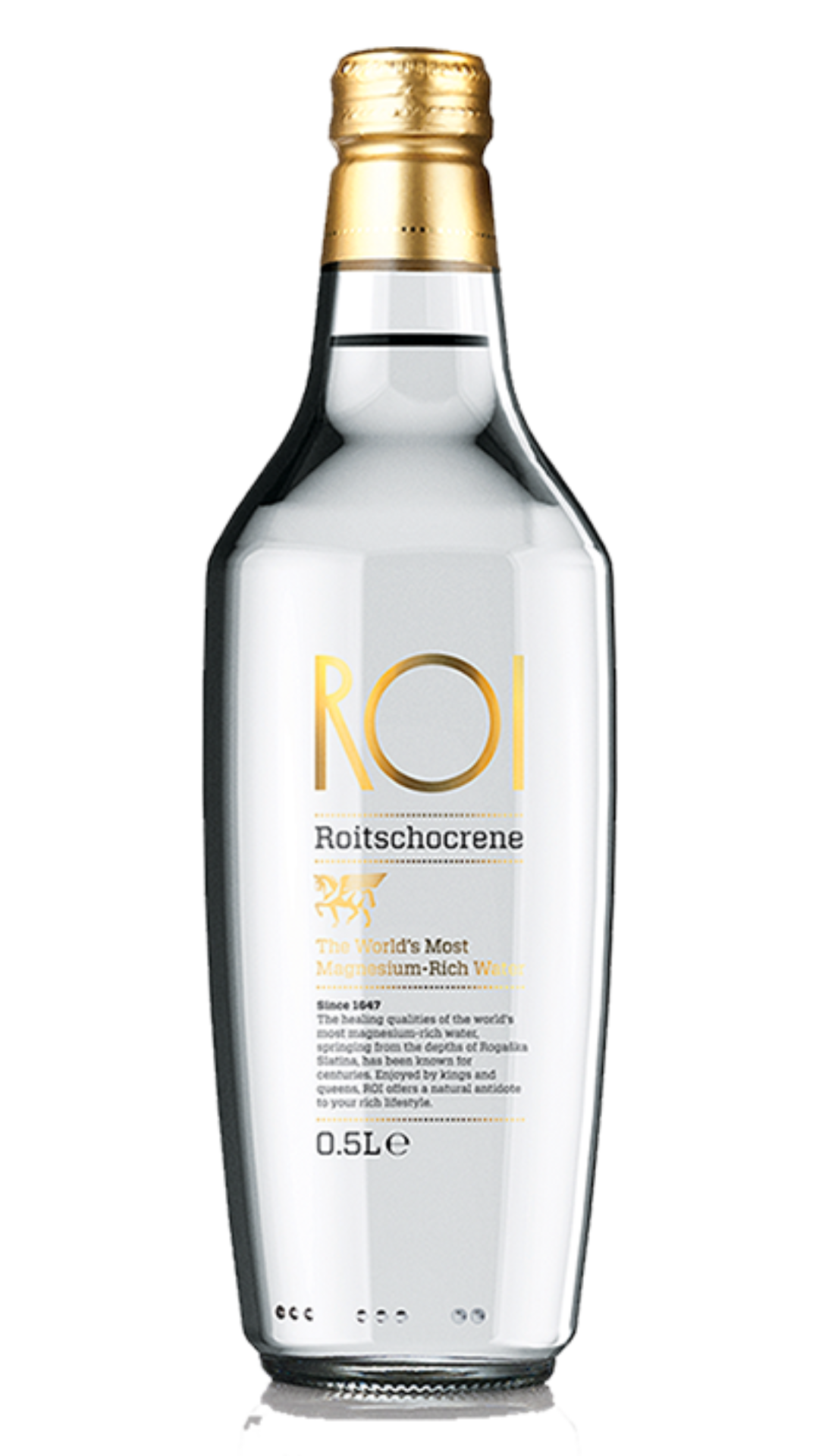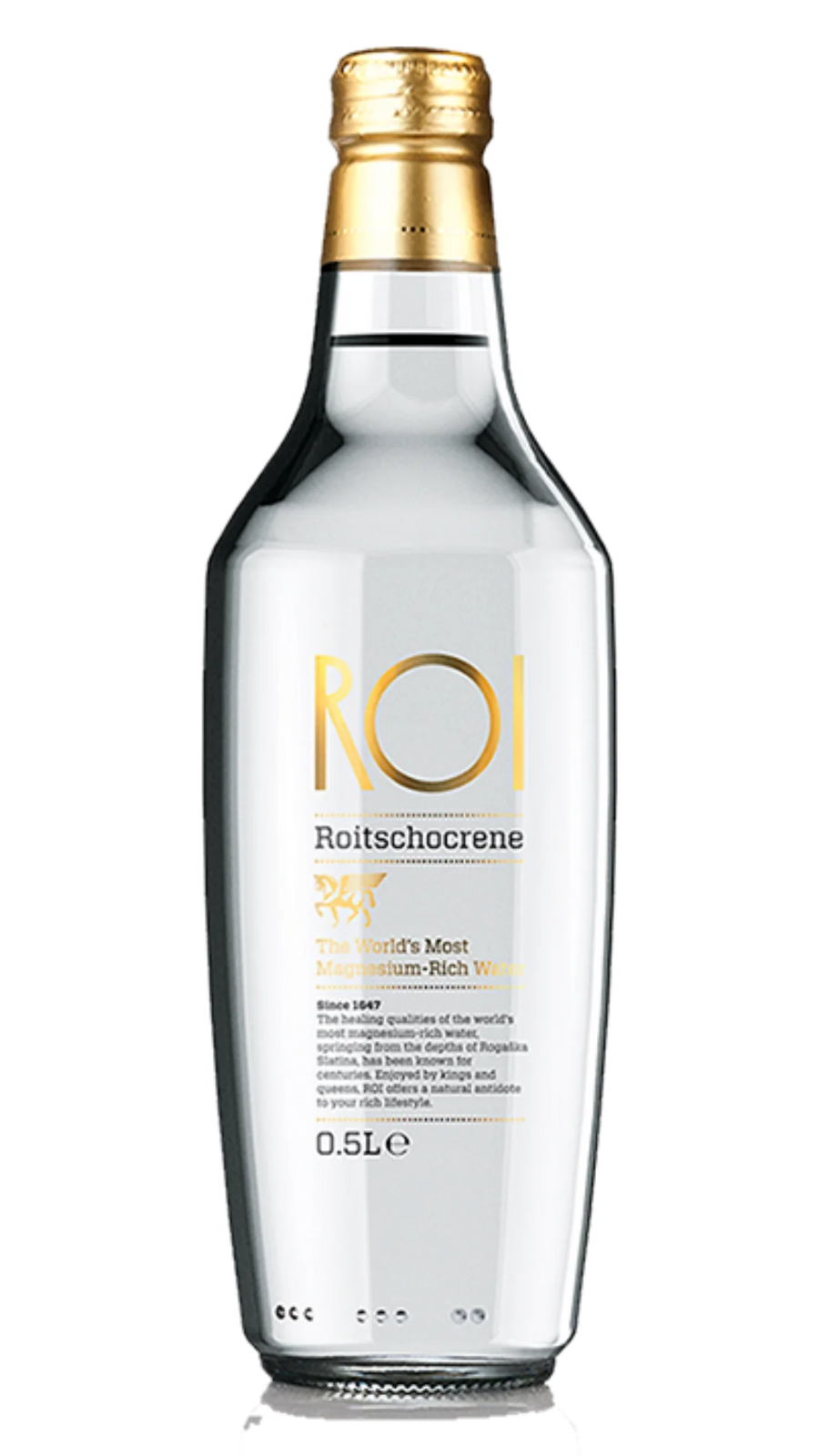OUR NUTRIENTS

Magnesium
Magnesium is essential for numerous bodily functions, including muscle and nerve function, blood sugar control, and blood pressure regulation. It also plays a role in bone health and energy production. A magnesium-rich diet can help prevent deficiencies that may lead to health issues like osteoporosis, cardiovascular problems, and type 2 diabetes. You can find magnesium in foods like nuts, seeds, whole grains, and leafy green vegetables. For more detailed information, you can explore the National Institutes of Health
Currently, an estimated 75% of Americans have daily magnesium intakes less than the Recommended Daily Intake, with similar figures estimated for most industrialized nations. These radical figures point not only to the need for improved diets, but also to the need for a deeper understanding of the pathways that bring magnesium into and out of the body.
To reach 550 mg of magnesium daily consumption (1x ROI Water Bottle intake) here’s an approximate breakdown of how much you might need to consume from various magnesium-rich foods:
· Pumpkin seeds : About 3.5 ounces (100 grams) provide 550 mg.
· Almonds : Around 7 ounces (200 grams) offer 560 mg.
· Spinach (cooked) : Approximately 3 cups (about 450 grams) contain 555 mg.
· Black beans (cooked) : Roughly 4.5 cups (about 900 grams) provide 540 mg.
· Quinoa (cooked) : About 5 cups (around 1,200 grams) contain 550 mg.
The body typically absorbs 20-50% of the magnesium from dietary sources .
Factors like the type of food, overall diet, and individual health can influence absorption. For example, magnesium from plant-based foods like spinach may be less bio-available due to compounds like oxalates, which can inhibit absorption1. On the other hand, magnesium from nuts and seeds is generally more readily absorbed. (source: NIH)
With ROI WATER 70-80% of the magnesium value is absorbed because the minerals in natural ionic form , making it an effective way to manage stress and improve overall well-being.
MORE on why Magnesium i s good for you overall : ANCIENT MINERALS

CALCIUM
Calcium is essential for building and maintaining strong bones and teeth. It also supports muscle function, nerve signaling, and blood clotting. Adequate calcium intake can help prevent osteoporosis and maintain overall bone health. You can find calcium in dairy products, leafy greens, fortified foods, and certain fish. For more details, you can explore the National Institutes of Health
Many adults today do not meet their recommended calcium intake. Studies indicate that calcium is considered a "nutrient of public health concern" due to widespread underconsumption, particularly among women and older adults (Source: NIH) ). This deficiency can lead to health issues like osteoporosis and weakened bone health over time.
The "best" source of calcium depends on your dietary preferences, tolerances, and needs. Here's a breakdown:
- Dairy products (milk, yogurt, cheese) : These are highly calcium-dense and easily absorbed by the body, making them ideal if you're not lactose intolerant.
- Fortified foods (orange juice, plant-based milk) : Great options for those who avoid dairy, as they offer high calcium content and good bioavailability.
- Sardines and salmon with bones : Excellent for those who enjoy seafood and want to benefit from additional nutrients like omega-3s.
- Leafy greens (kale, collard greens) : A plant-based option, though the calcium absorption may be slightly lower due to compounds like oxalates.
For most people, dairy and fortified foods are the most efficient sources. However, combining several options can ensure variety and meet your calcium needs.
Calcium absorption varies depending on the source:
- Dairy Products : About 30–35% of calcium from milk, cheese, and yogurt is absorbed. These are highly bioavailable sources.
- Fortified Foods : Calcium from fortified orange juice and plant-based milks is absorbed at a similar rate to dairy, around 30–35%.
- Fish with Bones : Calcium from canned sardines and salmon is well absorbed, with rates comparable to dairy (around 30–35%).
With ROI WATER about 50% of the calcium value is absorbed because the minerals in natural ionic form . It helps stabilize mood and supports neurotransmitter function, reducing stress-related tension.

POTASSIUM
Potassium is vital for maintaining fluid balance, supporting muscle contractions (including the heart), and transmitting nerve signals. A potassium-rich diet can help lower blood pressure, reduce the risk of stroke, and prevent kidney stones. Foods like bananas, oranges, potatoes, and spinach are excellent sources. For more details, you can explore the National Institutes of Health
Many adults today do not meet the recommended potassium intake. Globally, the average potassium consumption is around 0.08 oz/day (2.25g/day) which is below the World Health Organization's guideline of 0.123oz /day (3.5g/day) . Low potassium intake is often linked to diets high in processed foods and low in fruits and vegetables. This deficiency can increase the risk of high blood pressure, kidney stones, and cardiovascular issues. (Source: NIH)
To meet the daily potassium intake guideline of 3,400 mg for men and 2,600 mg for women , here's an approximate idea of how much you might need to consume:
- Bananas : About 7 medium bananas (0.450 mg each).
- Spinach (cooked) : Around 3 cups (0.839 mg per cup).
- Sweet Potatoes (baked with skin) : About 5 medium sweet potatoes (0.542 mg each).
- Milk : Roughly 4 cups (0.366 mg per cup).
- Salmon : Around 6 ounces (1,068 mg per 6 oz fillet).
The body absorbs about 90% of the potassium from dietary sources, which is a high absorption rate compared to other minerals. This efficient absorption occurs primarily in the small intestine through passive diffusion. Factors like overall diet, health conditions, and potassium-sodium balance can influence how well the body utilizes potassium. (Source: NIH)
With ROI WATER you receive high mineral absorption and high potassium absorption in one. You don’t need to eat 7 bananas per day.

BICARBONATE
Bicarbonate plays a key role in maintaining the body's pH balance, helping to neutralize excess acid. It supports digestive health, reduces acid reflux, and may enhance physical performance by buffering lactic acid during exercise. For more details, you can explore the National Library of Medicine .
Maintaining pH balance is essential for overall health, even in today's modern lifestyle. The body naturally regulates its pH levels to ensure optimal functioning of processes like digestion, metabolism, and oxygen transport. However, factors like stress, poor diet (high in processed foods), and lack of hydration can disrupt this balance, potentially leading to issues like fatigue, weakened immunity, and bone demineralization.
An unbalanced pH in the body can lead to various health risks depending on whether the imbalance is toward acidity ( acidosis ) or alkalinity ( alkalosis ):
Acidosis (Excess Acidity)
- Fatigue and Weakness : Low pH can impair energy production.
- Bone Health Issues : Chronic acidity may lead to calcium loss from bones, increasing the risk of osteoporosis.
- Kidney Stress : High acidity can overwork the kidneys, potentially leading to kidney stones or chronic kidney disease.
- Increased Risk of Gout : Excess acid promotes uric acid buildup, causing gout attacks.
- Digestive Problems : Acid reflux and heartburn are common symptoms.
Alkalosis (Excess Alkalinity)
- Muscle Cramps and Weakness : Caused by disrupted electrolyte balance, particularly calcium and potassium.
- Nervous System Issues : Symptoms like confusion, dizziness, or tingling sensations.
- Respiratory Problems : Shallow breathing or difficulty breathing in severe cases.
To maintain a healthy pH balance, focus on incorporating alkaline-promoting foods into your diet. Here's a list of foods and approximate daily intake values to support pH balance:
Alkaline-Promoting Foods
- Leafy Greens (Spinach, Kale): About 200–300 mg of calcium per 2–3 cups.
- Fruits (Bananas, Avocados): Bananas provide around 422 mg of potassium per medium banana; avocados contain about 485 mg of potassium per half.
- Vegetables (Broccoli, Sweet Potatoes): Broccoli has 288 mg of potassium per cup; sweet potatoes with skin offer about 542 mg of potassium per medium.
- Legumes (Lentils, Chickpeas): Lentils provide 731 mg of potassium per cup, while chickpeas offer about 474 mg per cup.
- Nuts and Seeds (Almonds, Chia Seeds): Almonds contain around 76 mg of magnesium per ounce; chia seeds have 95 mg of calcium per ounce.
- Herbal Tea (Chamomile, Ginger): Small amounts of minerals per cup, supporting hydration and alkalinity.
WHY YOU'LL LOVE IT

For Athletes: Boosts Muscle Recovery and Performance
For Athletes: Boosts Muscle Recovery and Performance Magnesium helps with muscle function and recovery, potassium supports hydration, and bicarbonate neutralizes lactic acid, reducing muscle soreness after intense exercise, keeping athletes at their peak.
For Moms: Supports Pregnancy, Breastfeeding, and Toddler Growth
Magnesium aids in muscle relaxation, potassium boosts energy, calcium strengthens bones, and bicarbonate helps maintain healthy pH levels, supporting moms during pregnancy, breastfeeding, and nurturing growing toddlers.
For Managers: Reduces Stress and Improves Focus
Magnesium helps with relaxation and sleep, calcium supports nerve function, potassium enhances mood, and bicarbonate helps balance pH levels, supporting a calm and focused mind during high-pressure situations.
For Everyone: Provides Essential Daily Minerals
Bicarbonate helps balance pH, magnesium supports nerve and muscle function, calcium strengthens bones, and potassium regulates fluids, ensuring a natural boost to overall health for anyone, anywhere.
Happy Customers

ROI Water is incredibly refreshing and pure. Its natural carbonation and mineral-rich composition make it my top choice.

I love the unique taste of ROI Water! It’s smooth, crisp, and packed with magnesium. A true hydration luxury.

ROI Water is the best! Its naturally carbonated bubbles and rich minerals give me a refreshing and balanced feeling.

Truly refreshing! ROI Water’s natural carbonation and mineral-rich content make it the healthiest and most satisfying water to drink.
Us vs Them


OUR BLOG

Frequently asked questions
What makes ROI Water different from other bottled waters?
What makes ROI Water different from other bottled waters?
ROI Water is naturally carbonated and sourced from the ancient springs of Rogaška Slatina, Slovenia. It is the most magnesium-rich bottled water in the world, providing a unique taste and numerous health benefits.
How is ROI Water naturally carbonated?
How is ROI Water naturally carbonated?
ROI Water's natural carbonation is a result of thousands of years of filtration through the earth's geological layers. It rises to the surface naturally, without the need for artificial pressurization.
What health benefits does ROI Water offer?
What health benefits does ROI Water offer?
ROI Water is rich in magnesium, which helps with hydration, balance, and overall wellness. Its mineral composition supports muscle function, hydration, and bone health.
Where is ROI Water sourced from?
Where is ROI Water sourced from?
ROI Water is sourced from the ancient underground springs of Rogaška Slatina, Slovenia, a location known for its natural, mineral-rich waters with over 3,400 years of history.















